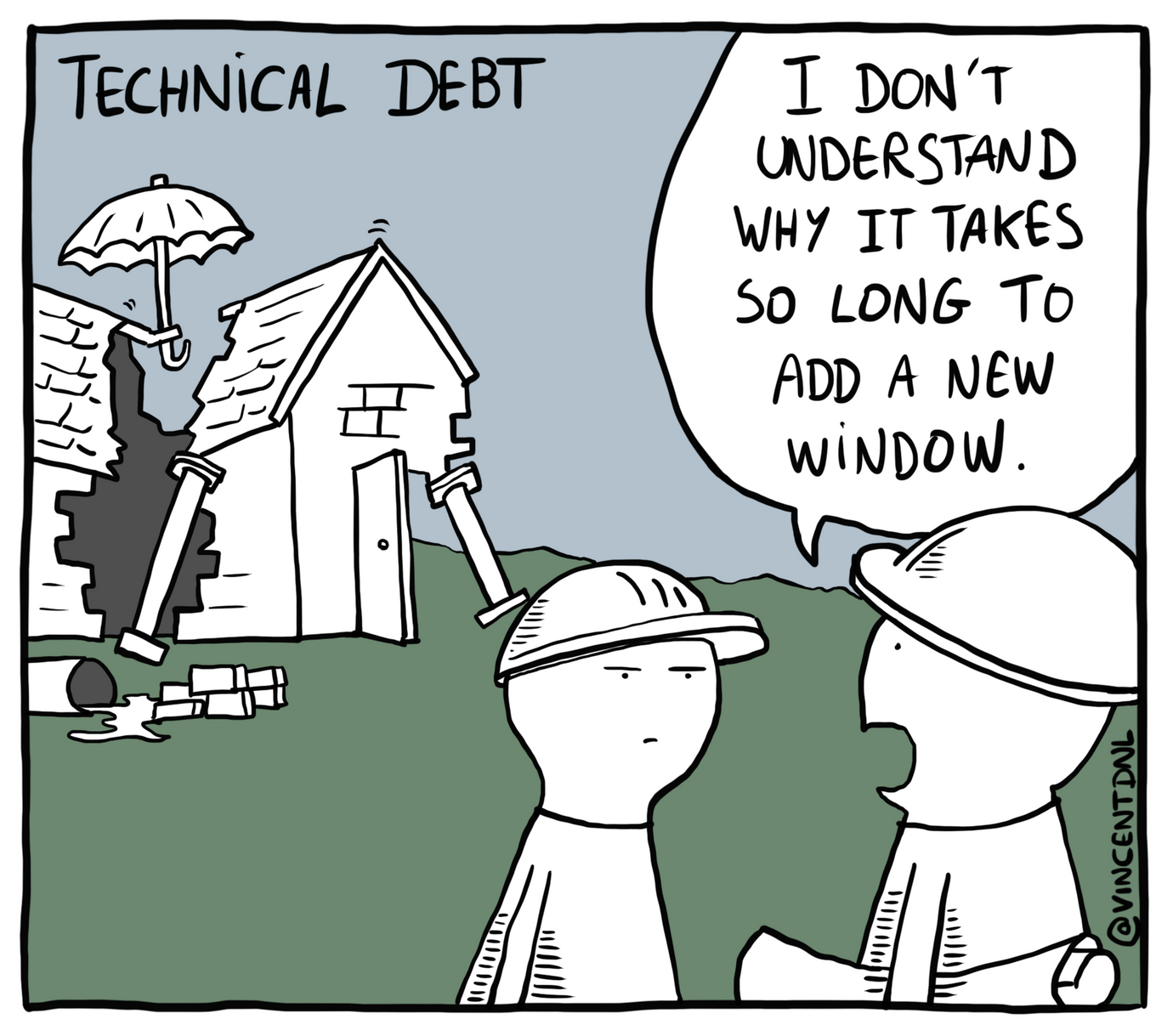Managing Tech Debt
Image Source
Every one of us has some level of tech debt, whether we know it or not. As soon as you endeavor to build software, run a business that uses software, or really just turn on a computer, you are taking on tech debt. Before diving into how we think about managing tech debt here at LoanBoss, a definition is in order so that the rest of the post makes sense. I like ProductPlan’s straightforward glossary definition:
tech debt describes what results when development teams take actions to expedite delivery of a piece of functionality or a project which later needs to be refactored1
I would extend it more broadly though to include all aspects of leveraging (see what I did there) technology in your business. The platforms and applications you choose come with their own debt, your cloud provider comes with its debt, and even a choice to not manage it can be debt. As in you will eventually have to pay it back.
Why is tech debt management important? The Southwest Airlines flight cancellations in December ‘22 provides a relevant example of what happens when unmanaged tech debt demands to be repaid in a single, significant event. As reported by Gary Leff2 based on an open letter from SWA’s own pilot union to its members, one of the primary causes of the cancellations was “a long-term investment deficit in the systems and technology to properly track their workforce.”
Long-term is the key here. It seems that the tech debt may have snuck up on SWA. It didn’t. That investment deficit is the lack of tech debt management over time, decades in this case. Tech debt management isn’t a one and done activity. It is an ongoing strategic imperative that needs to be operationalized. In the case of SWA, not managing it invited a catastrophe. And unfortunately, an avoidable catastrophe.
Back to what’s interesting about managing tech debt at LoanBoss. Our debt management platform offers myriad concepts for how we think about managing our tech debt. The debt instruments themselves provide analogs to financing options for tech debt. Alerting on market trends and loan characteristics (e.g., maturity date) align nicely with some of our core observability platform concepts of monitoring and alerting. And the constant vigilance our clients get by having an always on, real time view into their debt portfolios is instructive for us on how to think about our technology portfolio and the tech debt associated with it.
Now this is where I get to be a bit creative and outside the bounds of contemporary debt instruments. I have made up my own, non-existent, security called the undated puttable bullet bond to explain how SWA financed their tech debt. The put was an option that the technology solutions themselves held. They have the right, but not the obligation, to demand early repayment of the principal. And in this case, not on a specific option date, but whenever they wanted. The bullet simply indicates that ALL the principal came due, no amortization, no partial payments, all of it. Their technology solutions selected Christmas ‘22 to collect. And while cash was one of the payment types, so was reputation, customer experience, and teammate loyalty. All that to say, please don’t let your tech debt financing instrument be an undated puttable bullet bond.
Let’s put tech debt in terms of types of loans.
- LINE OF CREDIT - the most straightforward is something akin to a line of credit that we are constantly tapping into and paying back. This is for items such as dependency updates and capacity set asides in our development iterations for small refactoring.
- DEBT FUND/BRIDGE - short term loans in the form of project-based funding can tackle specific aspects of technical debt when small refactoring isn’t an option. Maybe that’s a major version upgrade of a database platform or the swap out of a reporting service. In our case, AWS is a fantastic partner because they indicate when major version upgrades are mandatory and we take on short term loans to take care of it.
- PERM LOAN – refi a shorter term into a long term financing. Establishing a permanent data strategy that includes a master data management platform that advances how we manage our data is an example of a more permanent architecture change that we are financing.
- HEDGE - cloud infrastructure as code abstraction that gives us the ability, but not the obligation, to move clouds or even underlying services in the cloud. It costs more upfront but the risk reduction is worth it.
Caveat borrower - the goal isn’t zero tech debt. Leverage used correctly and at the right levels can enhance company value. Just make sure you know what you have in the portfolio. Observe that portfolio all the time. All of this starts with getting your arms around your portfolio if you haven’t done that already. Put that tech debt somewhere you can see it and the management of it will be achievable.
Visibility into your tech debt portfolio (or simply your tech portfolio in general), thoughtful approaches to the types of instruments you use to finance the tech debt, and the right conversations for how to invest will put your customers, your teammates and the business in a better place in the long run.
I’ll leave you with these final thoughts - not managing your tech debt means you have selected the undated puttable bullet bond financing approach.
1 https://www.productplan.com/glossary/technical-debt/
Email us at theboss@loanboss.com to see if LoanBoss is right for you.
Check out our website to learn more!

